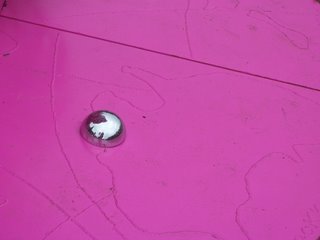The $25,000 Wynne prize is looking pretty tatty at the moment. The newly-crowned winner should be dethroned, sent home empty-handed, and the trustees should look suitably abject, and cast around forlornly for a replacement.
The problem: the winner,
Sam Leach, has copied from a 1660 painting,
Boatmen Moored on the Shore of a Lake, by a Dutch painter called
Adam Pynacker.
The Wynne Trustees were out and about today, defending their decision. One spouted something about there being no conventions for referencing another work... even
Edmund Capon, Director of the Art Gallery of New South Wales, and himself a Trustee, has been stubbornly holding his line.
"Referencing", my foot. It's out-and-out plaguarism, as can be clearly seen from a
side-by-side comparison in today's
Herald.
The Wynne prize, one of the more lucrative art prizes in Australia, is dished out each year by the trustees of the Art Gallery of New South Wales for an Australian landscape painting. Past winners have stretched the meaning of the word landscape (one, I recall, seemed more of a self-portrait than landscape). But it's never been awarded for a landscape originally done before any European had even heard of Australia.
The media has been remarkably restrained, for some unfathomable reason. They reiterate that the painter had not tried to conceal the similarity - but then, he had not made clear the extent of similitude - which omission was quite egregious. The exact composition of the painting has been retained, down to reproducing the tendrils of branch across the top and the variegated wood snaking across the bottom. Only the subject boat/men of the original have been painted out.
Whether you argue the blatancy of the act or the lack of Australian landscape, the award should obviously be revoked.
In their favour, the Trustees cannot be expected to be across the full catalogue of the last five centuries of European art. But once the truth is made clear, it is remarkably stupid to attempt to defend the indefensible. They only get egg on their faces if they open their mouths.
Edmund Capon, a highly respected member of the Sydney establishment, has in recent times made increasingly serious noises about retiring. If he doesn't change tack on this issue, one way or another his retirement will be hastened.
The whole thing is so stupid, and to persist is even worse.
Update 29-Apr-2010:
The Trustees' verdict is in. And if
you're of the same mind, "common sense has prevailed" and the artist will keep his prize. The decision is reported
here in the
Herald. The more telling comments:
a) The Trustees said that when awarding the prize, they recognised the winner had the "light and air" of a Dutch 17th century painting, but also "appreciated its quality and mysterious implications of the natural world".
b) "none of the 10 trustees present was in favour [of revoking the prize]".
c) ...however, "some felt that the artist should have made a greater declaration of the source of inspiration".
d) Capon: "there's no way in the world that the same board of trustees will look at the Wynne next year without the recollection and the memory of what's happened this year".
e) The art gallery board said the painting was an "idealised landscape, one where time and place are indistinct."
Bollocks. The clear translation: the Trustees had egg on their faces, but didn't want it to seem even worse by revoking the prize. Idiots.
The last words go to some letter-writers to the
Herald (to be found
here):
"The Wynne Prize judges could not have done otherwise. By revoking the prize, they would have disqualified themselves and made themselves unfit in the first place to award the prize for a copy of a painting made in the Netherlands before the discovery of Australia."
Bela Somssich-Szogyeny
and
"The board of trustees of the Art Gallery of NSW must be living in an ''idealised'' reality. They are either disingenuous, ignorant or plain wrong to suggest that Sam Leach's Wynne-winning painting was an ''idealised landscape, one where time and place are indistinct''. I can inform them the time is 17th century, the place, Italy."
Glen op den Brouw





















 Formal Rags - Joachim van Den Hurk
Formal Rags - Joachim van Den Hurk









